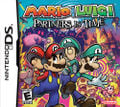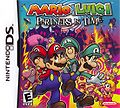List of Mario & Luigi: Partners in Time pre-release and unused content
This is a list of pre-release and unused content for the game Mario & Luigi: Partners in Time.
Early builds[edit]
Localization preview[edit]
- One scene featured Luigi being hit on the head by a washtub falling from the celling, a common gag in Japanese slapstick. Members of Nintendo's North American localization team, Treehouse, explained that the joke would not be familiar to American audience, and thus the washtub was changed to a bucket in the final game [1].
Press kit material[edit]
- The game was originally named Mario & Luigi 2.
- An early screenshot depicts Mario, Luigi, and their baby selves fighting two red shoe-clad Blooper foes (called Scoot Bloops) in the Vim Factory. Unfinished code for the Scoot Bloops remain the final build of the game (see below).
- Another screenshot shows the brothers using a Mix Flower on two Boo Guys in Hollijolli Village, while Boo Guys were not present in this area in the final game and Mix Flowers do not look or act this way in the final game.
- There are also screenshots of the four brothers using what appears to be a purple Spiny Shell as a Bros. Item. This item would act like a Koopa Shell, but would be hammered instead of kicked.
- Baby Mario's initial artwork erroneously depicted him as having red shoes rather than his normal blue ones, although his shoe coloration would appear to have always been consistent throughout all of the actual game's programming.
Instruction manual[edit]
- In page 27 of the instruction booklet there are two images of Mario leveling up, here instead of having "stache" he has "hige" (a Japanese word for mustache).
Unused data[edit]
[edit]
A debug menu can be accessed using the Action Replay code 94000130-fffa0000 + 1205e768-0000000c + 1205ef50-0000000c + d2000000-00000000. While save data is being loaded, the player must hold ![]() +
+ ![]() .
One of the selectable rooms include the western side of Beanbean Castle Town, a grassy field with stairs, a test room with Yoshi's Eggs, and a debug room meant to test the Bros' capabilities.[2]
.
One of the selectable rooms include the western side of Beanbean Castle Town, a grassy field with stairs, a test room with Yoshi's Eggs, and a debug room meant to test the Bros' capabilities.[2]
Scoot Bloop[edit]
An enemy name in the ROM, Scoot Bloop, was unused. In all versions of the game excluding the Spanish release and South Korean release, it has been translated. Sprites of this "Scoot Bloop" have been ripped from the game[3] and its unused data discovered.[4] Apparently, Scoot Bloops were intended to attack by ramming into the player. Due to the data being unfinished, battling them in-game and letting them attack will cause a Scoot Bloop to attack and not return, or freeze the game. Another unfinished attack is the Scoot Bloop walking in front of one of the bros and freezing in place, ultimately softlocking the game and forcing the player to reset.
| Language | Name | Meaning | Notes |
|---|---|---|---|
| Japanese | オカゲッソー[?] Oka Gessō |
Land Blooper | |
| French | Scoot Bloop[?] | - | |
| German | Sausebloop[?] | Whiz Bloop | |
| Italian | Yoob[?] | Yoob is actually another enemy. The reason that this name fills this string in Italian language text is unknown. |
Miscellaneous[edit]
Although the Japanese version of this game only gives players the option to play in Japanese, it actually contains at least a partial script in English, French, German, Italian, and Spanish as well[5]. These often differ from what would eventually be released in the European version of the game. A list of changes can be found below.
| French | ||
|---|---|---|
| Enemies | ||
| English Name | Early Name | Final Name |
| Lakitufo | Lakitufo | Lakitovni |
| Spiny Shroopa | Shroopa Hériss | Xhampik |
| Swiggler | Swiggler | Xhwiggler |
| Coconutter | Coco | Cocomaso |
| Gnarantula | Gnarantula | Nebulantula |
| Dr. Shroob | Dr Shroob | Dr Xhampi |
| Junior Shrooboid | Shrooboïde Junior | Jeune Xhampi |
| Handfake | Faussemain | Mainnoire |
| Mrs. Thwomp | Mme Twomp | Mme Thwomp |
| Blazing Shroob | Pyroshroob | Pyroxhampi |
| Shroid | Shroïde | Xhampoïde |
| Skellokey | Squelèdac | Pokeyrex |
| Elder Shrooboid | Vieux Shrooboïde | Vieux Xhampoïde |
| RC Shroober | Shroober RC | Téléxhampi |
| Shrooba Diver | Shroobaplonge | Xhaphandrier |
| Snifaro | Snifaro | Sarcosnifit |
| Shrooboid Brat | Bébé Shrooboïde | Bébé Xhampoïde |
| Princess Shroob | Princesse Shroob | Princesse Xhampi |
| Sunnycide | Tulesoleil | Têtedœuf |
| Shroob-omb | Shroob-omb | Xhamp-omb |
| Commander Shroob | Général Shroob | Général Xhampi |
| Shroob | Shroob | Xhampi |
| Support Shroob | Renfort Shroob | Renfort Xhampi |
| Shrooblet | Shrooblet | Mini-Xhampi |
| Red Coconutter | Coco rouge | Cocomaso rouge |
| Gold Koopeleon | Koopaléon d'or | Koopaléon doré |
| Guardian Shroob | Garde Shroob | Garde Xhampi |
| Shroobsworth | Grand Shroob | Grand Xhampi |
| Shroob Rex | Rex Shroob | Dracox |
| Shrowser | Shrowser | Xhowser |
| Tashrooba | Tashrooba | Xhatonos |
| Ghoul Guy | Maskass éclair | Sombre Maskass |
| Intern Shroob | Endoshroob | Petit Xhampi |
| German | ||
| Enemies | ||
| English Name | Early Name | Final Name |
| Elite Boom Guy | Elite Boom Guy | Elite Bumm Guy |
| Red Coconutter | Roter Kokosnussling | Roter Kokosnussl. |
| Italian | ||
| Enemies | ||
| English Name | Early Name | Final Name |
| Koopeleon | Koopeleo | Koopeleonte |
| Gold Koopeleon | Koopeleo d'oro | Koopeleonte d'oro |
External links[edit]
References[edit]
- ^ Kotaku: Nintendo's Secret Weapon (accessed June 13 2013)
- ^ Mario & Luigi: Partners in Time - The Cutting Room Floor. Retrieved June 29, 2018.
- ^ http://www.spriters-resource.com/ds/marioluigipartners/sheet/46742
- ^ http://www.youtube.com/watch?v=LwiXuxEVfMc
- ^ In all releases of the game, enemy names are found in uncompressed tables at $\BData\mfset_MonN.dat item and badge names are found at\mfset_AItmN.dat \mfset_BadgeN.dat \mfset_UItmN.dat and \mfset_WearN.dat. Japanese names are stored in a currently unknown format, while all other names are stored in ASCII.





